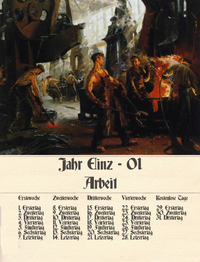Liothidian Revolutionary Calendar
The Liothidian Revolutionary calendar (Liothidian: liothidischer revolutionärer kalender), also commonly called the All-Socialist calender (Allsozialistischer Kalender), is a calendar created and implemented during the August Revolution, and remains in use today in Liothidia. Despite early attempts at a complete overhaul of the dating system, including suggestions of basing the calender over the Autumnal equinox, senior revolutionaries questioned its viability among the general populace.
As a result, the revolutionary calendar officially took the structure of the Gregorian calendar and renamed each month, removed all holidays, national and religious and re-aligned the years to establish 1919 as year zero. The calendar introduced Pre-Revolution (Vorrevolution, VR) and Post-Revolution (Nachrevolution, NR) replacing Anno Domini and Before Christ.
Overview and origins
Suggestions
Autumnal Equinox
Lunar
Final decision
Calendar design
Due to the simplistic nature of the revolutionary calendar, the design does not differ significantly from the previous Gregorian calendar. While the days and months are renamed, the biggest difference is the year, owing to the revolutionary government reseting the years with 1919 being declared the beginning of the "Socialist Era." The calendar also replaced the previous month-day-year structure for day-month-year.
Between 1919 and 1921, years appeared in writing as Latin numerals, with the Latin Numeral I indicating the first year of the worker's republic and subsequent numerals denoting the number of years passed since (for example, 2019 would have appeared as I-XCIX). This was scrapped due to widespread belief that Latin Numerals were "too imperialistic."
Despite the abolition of religion, Sundays (renamed to Letzertag, "Last Day") remained official days of rest and festivities. The new calendar also abolished every national and religious holiday previously celebrated under the monarchy, with the introduction of both political and civil holidays as their replacements. The only holidays to be carried over was New Year's and International Workers' Day, the latter was renamed to United Workers Day (Vereinigte Arbeitertag) and was extended to two-days (the Monday and Tuesday; Erstertag and Zwietertag respectively).
Months
The Revolutionary calendar year begins the same as the Gregorian calendar, on the 1st January, yet each month was given a new name, often reflecting periods during the August Revolution, or terms relating to their traditions. Each month would include new national holidays in relation to their name, with Solidarität including mandatory donations to state-run charities.
- 1. Morgendämmerung (Liothidian for Dawn), replaces January.
- 2. Solidarität (Liothidian for Solidarity), replaces February.
- 3. Blühen (Liothidian for Bloom), replaces March.
- 4. Mühe (Liothidian for Toil), replaces April.
- 5. Arbeit (Liothidian for Labour), replaces May.
- 6. Ausdauer (Liothidian for Perseverance), replaces June.
- 7. Barrikade (Liothidian for Barricade), replaces July.
- 8. Aufstand (Liothidian for Insurrection), replaces August.
- 9. Seig (Liothidian for Victory), replaces September.
- 10. Ernte (Liothidian for Harvest), replaces October.
- 11. Einheit (Liothidian for Unity), replaces November.
- 12. Dämmerung (Liothidian for Dusk), replaces December.
The sub-committee of RANKOM tasked with implementing the new calendar, made much effort to celebrate the months' names as a decription of the "revolutionary year", in which the year (1918) began with rising solidarity among workers and peasants in face of economic stagnation, corporate and political oppression. This was followed by the blooming of spring, the toils and labours of the "oppressed masses", perseverance through increased repression, followed by mass protests and the erection of barricades, to the insurrection itself and ultimately victory over the imperial government. The victorious socialist state harvested the years crops, through bounty it unified and the sun set on the revolutionary year.
Days of the week
Parallel to the renaming of the months, the Revolutionary calendar renamed all days of the week. However, the months were divided into weeks, with holdover days named as Complimentary Days. The days of the week are named simply:
- Erstertag (First Day)
- Zweitertag (Second Day)
- Drittertag (Third Day)
- Viertertag (Fourth Day)
- Fünftertag (Fifth Day)
- Sechstertag (Sixth Day)
- Letztertag (Final Day)
